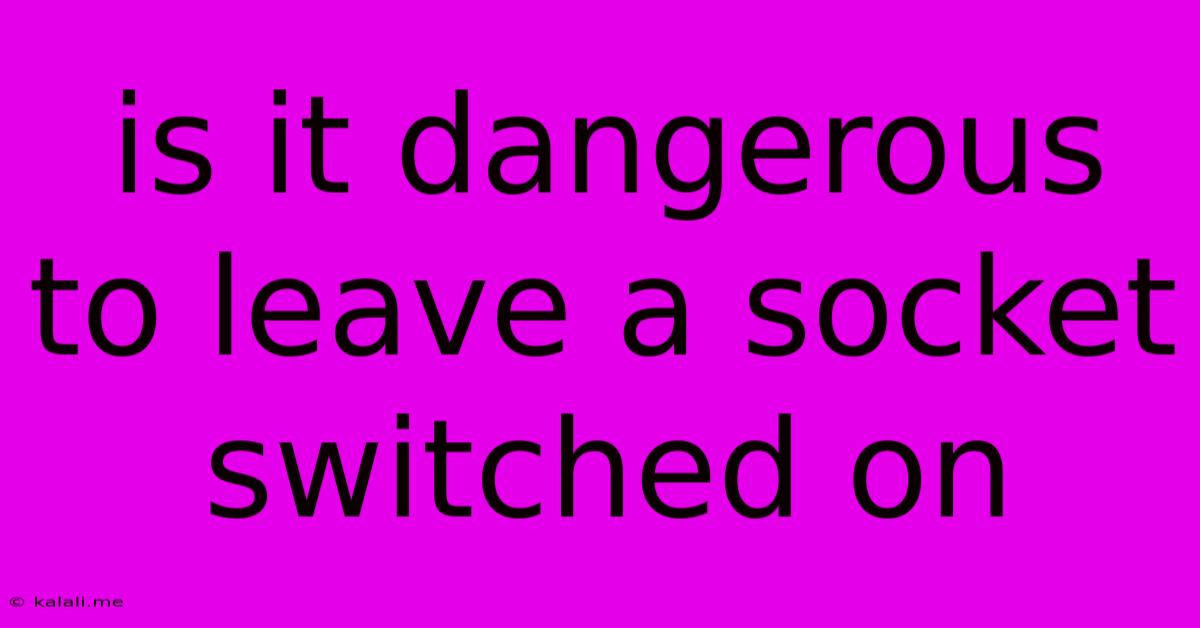Is It Dangerous To Leave A Socket Switched On
Kalali
May 20, 2025 · 3 min read

Table of Contents
Is It Dangerous to Leave a Socket Switched On? Unplugging vs. Leaving Plugged In
Leaving a socket switched on – is it really dangerous? Many of us have pondered this question, often leaving lights or chargers plugged in even when not in use. While it might seem insignificant, understanding the potential risks and energy implications is crucial for both safety and sustainability. This article will delve into the dangers, dispel common myths, and offer practical advice on responsible electrical usage.
The Myth of Phantom Power Drain: A common concern is the "phantom load" or "vampire energy" consumed by devices even when switched off. While it's true that some devices draw a small amount of power even when not actively used, this is generally negligible compared to the energy used when the device is on. The biggest energy drain comes from leaving appliances and electronics actively running. Leaving a socket switched on itself doesn't contribute significantly to this phantom load unless a device is constantly drawing power.
Real Dangers Associated with Switched-On Sockets:
-
Shock Hazard: While a switched-on socket itself doesn't directly cause shocks, it presents a significantly increased risk if something conductive, like a metal object or a person with wet hands, touches both the live and neutral terminals simultaneously. This is far more dangerous than a switched-off socket, where the risk is significantly reduced.
-
Fire Hazard: If a faulty appliance or device is plugged into a switched-on socket, the risk of overheating and subsequent fire is drastically increased. A switched-off socket minimizes this risk.
-
Children and Pets: Children and pets are especially vulnerable to electrical hazards. A switched-on socket presents a greater temptation and risk for accidental contact. Protecting children and pets from potential dangers associated with electrical outlets is paramount.
-
Increased wear and tear: While often negligible, constantly leaving a socket switched on can contribute to increased wear and tear on the outlet and internal components over a long period, potentially leading to malfunctions or increased risk of failure.
Best Practices for Safe Electrical Usage:
-
Unplug when not in use: The safest practice is to unplug devices and appliances when not in use, especially high-power appliances like hair dryers and heaters. This eliminates the risk of electrical shock and fire.
-
Use surge protectors: Surge protectors not only protect your devices from power surges but also provide an additional layer of safety. They often have built-in switches, making it easier to control the power to multiple devices.
-
Regular safety checks: Periodically inspect your electrical outlets for any signs of damage or loose wiring. If you notice any issues, contact a qualified electrician immediately.
-
Childproofing: Use safety covers for electrical outlets, especially in areas accessible to children and pets.
Conclusion:
While the energy consumed by a switched-on, but unoccupied, socket is minimal, the safety risks associated with it are significantly higher than a switched-off socket. Prioritizing safety and responsible energy consumption involves unplugging devices when not in use. It's a small habit that can make a big difference in reducing the risk of electrical hazards and contributing to a more sustainable future. Therefore, it's always safer to err on the side of caution and unplug your appliances and devices when not needed.
Latest Posts
Latest Posts
-
South Park The Stick Of Truth Homeless
May 21, 2025
-
How Long Does An Alignment Take
May 21, 2025
-
How Can You Tell If A Platy Is Pregnant
May 21, 2025
-
Can You Put Water In Your Coolant
May 21, 2025
-
Reference Name In India India Visa
May 21, 2025
Related Post
Thank you for visiting our website which covers about Is It Dangerous To Leave A Socket Switched On . We hope the information provided has been useful to you. Feel free to contact us if you have any questions or need further assistance. See you next time and don't miss to bookmark.